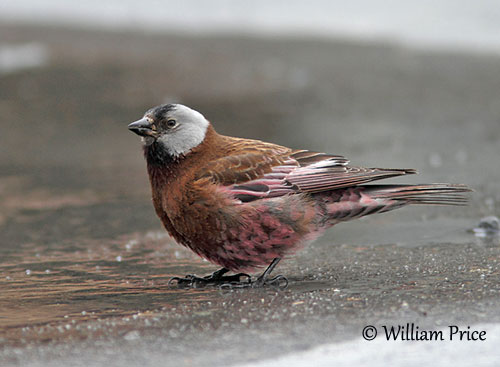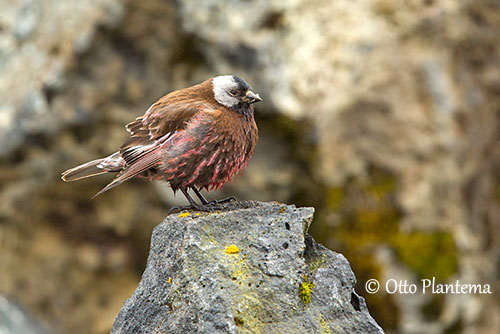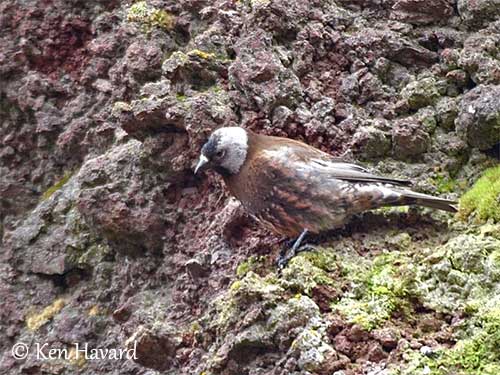
Fr: Roselin à tête grise
Ang: Grey-crowned Rosy-Finch
All: Schwarzstirn-Schneegimpel
Esp: Pinzón Montano Nuquigrís
Ita: Fringuello roseo capogrigio
Nd: Grijskruinbergvink
Sd: grånackad alpfink
Photographers:
Ken Havard
My Bird Gallery & Flickr gallery 1 & Flickr gallery 2
Otto Plantema
Trips around the world
William Price
PBase-tereksandpiper & Flickr William Price
Text by Nicole Bouglouan
Sources:
HANDBOOK OF THE BIRDS OF THE WORLD Vol 15 by Josep del Hoyo-Andrew Elliot-David Christie - Lynx Edicions – ISBN: 9788496553682
Ottaviani, M. (2008) Monographie des Fringilles (fringillinés – carduélinés) – Histoire Naturelle et photographies, Volume 1. Editions Prin, Ingré, France, 488 p.
L’ENCYCLOPEDIE MONDIALE DES OISEAUX - Dr Christopher M. Perrins - BORDAS - ISBN: 2040185607
All About Birds (Cornell Lab of Ornithology)
Bird Web (Seattle Audubon Society)
Wikipedia, the free encyclopaedia
The Birds of North America online
What Bird-The ultimate Bird Guide (Mitchell Waite)
Behaviour of the Aleutian Grey-crowned and Brown-capped Rosy Finches Leucosticte tephrocotis
Grey-crowned Rosy-Finch
Leucosticte tephrocotis
Passeriformes Order – Fringillidae Family
INTRODUCTION:
The Grey-crowned Rosy-Finch is a species of extreme environments and six subspecies share the wide range from Bering Sea islands to E California. These races vary in size and amount of grey on male’s head. They can be seen from sea-level up to 3,000 metres of elevation.
Mainland and island races live in slightly different habitat types where they feed on insects, seeds, buds and leaves. They nest among boulders, under rocks or in crevice in cliff, and build a bulky nest inside the chosen cavity. Both parents feed and tend the young.
The Grey-crowned Rosy-Finch has currently stable populations because they breed in remote sites where impact of human activity is reduced. The species is not globally threatened.
DESCRIPTION OF THE BIRD:
Biometrics:
Length: 14-16 cm
Weight: 21-29 gr
Both races « griseonucha » and « umbrina » are displayed on this page. They live on Bering Sea islands and Aleutian Islands. They are the largest subspecies with a length of 17-21 centimetres and a weight of 41-60 grams.

The Grey-crowned Rosy-Finch is medium-sized to large, depending on the subspecies. They have long wings and long, forked tail.
The male of the nominate race has black forehead, chin and throat. The pale grey hindcrown patch extends from eye to nape. The amount of grey on the head may vary.
The upperparts are brown with indistinct darker streaks on mantle and back. Scapulars are more heavily streaked browner. The brown rump and uppertail-coverts show pale pink broad fringes and tips to feathers. The tail is blackish with pale brown or pink fringes. On the upperwing, coverts, alula and flight-feathers are black and variably fringed and/or tipped pale pink.
The underparts are brown with breast and belly feathers broadly-tipped dark brown. Flanks, lower belly and undertail-coverts are broadly fringed pinkish.
The bill is slate-grey with white nasal tufts. It becomes pale brown with pale yellowish base of lower mandible in non-breeding season. The eyes are very dark to black. Legs and feet are black.
The female is paler or duller brown than male. Forehead and crown are browner with blackish tips. The grey patch of hindcrown is reduced or absent. She lacks the pink fringes and tips, but wing-coverts and flight-feathers are tipped/edged pale buff or whitish.
The juvenile has dark grey head, upperparts and underparts with buff brown tips to upperwing-coverts and edges of flight-feathers bases. Undertail-coverts are whitish with broad grey central shafts and tips.
SUBSPECIES AND RANGE:
The Grey-crowned Rosy-Finch has six subspecies.
L.t. griseonucha (displayed) or Grey-faced Rosy-Finch is found on Commander Islands and Aleutians, E to Kodiak Island and W Alaskan Peninsula.
This race is largest and appears darker overall, but especially on breast.
L.t. umbrina (displayed) is found on Hall Island, St Matthew Island and Pribilof Islands in Bering Sea.
This race is very similar to previous, but it has longer bill. The plumage is darker to blackish above and below, and especially on head and throat. The dark brown plumage is mottled blackish on breast, mantle and back.

L.t. littoralis is found in SC Alaska E to W Canada and S in W USA from Washington and Oregon to N California. It winters in S of breeding range E to C Montana, W Nevada, N Utah and C New Mexico.
This race is similar to nominate but it is smaller. It has shorter bill than “umbrina”. It has fairly dark plumage.
L.t. tephrocotis (nominate race described above) or Grey-crowned Rosy-Finch occurs in N and C Alaska E to NW Canada and NW USA (NW Montana). It winters from S British Columbia E to SW Saskatchewan and South Dakota, S to NE California, Nevada, Utah, W Colorado and N New Mexico.
L.t. wallowa is found in NE Oregon (Wallowa Mts). It winters S to WC Nevada and CE California.
This race resembles nominate but it has duller underparts and darker back feathers.
L.t. dawsoni is found in E California (Sierra Nevada and White Mts).
This one has more slender bill and rounded wingtips, paler upperparts and darker grey underparts.
HABITAT:
The Grey-crowned Rosy-Finch occurs from sea-level to 3,000 metres of elevation. It usually breeds in alpine environment near snow fields and glaciers, cliffs, talus and rocks.
The island races breed on lower-level tundra, cliffs, hillsides, grassy dunes, rocky beaches, scrubby areas, roadside edges and human settlements on Alaskan islands.
They winter in similar habitats but also in mountain valleys, plains and towns.
Both races “griseonucha” and “umbrina” are sedentary and remains on their islands all year round.
CALLS AND SONGS: SOUNDS BY XENO-CANTO
The Grey-crowned Rosy-Finch gives harsh “cheep, cheep” notes in flight or when in flocks. The contact call is a buzzy “chew” and variations including “see-ew” or “chew-woo” are given before to take-off. The alarm call is similar, and a high-pitched “peee” and loud chirps are given when a predator is approaching the nest.
The Grey-crowned Rosy-Finch sings at start of breeding season. The male utters a series of slow “chew” notes or “jeew jeew jeew” descending whistles interspersed with buzzing notes. The male sings from the ground or sometimes in flight, usually directed at female.
BEHAVIOUR IN THE WILD:
The Grey-crowned Rosy-Finch feeds primarily on seeds of grasses and weeds in winter. They may eat salt too. During summer, it feeds on insects and also eats buds and leaves. The adults feed the young mostly with insects carried in their throat pouch.
It forages on the ground or on snow. Insects can be caught in flight, but it also benefits from insects caught in winds and deposited on snow where they freeze.
During the nesting period, they forage in barren, rocky or grassy areas adjacent to their nesting sites.

The Grey-crowned Rosy-Finch is monogamous. During the courtship displays, the male is facing the female with half-spread and lowered wings, before raising and slowly lowering them again. Other displays show the male with sleeked plumage or ruffled body feathers, while the tail is slightly raised and the wings drooped. It crouches on the ground in front of the female, and both birds advance towards each other until they touch their bills.
The female builds the nest and incubates the eggs alone, but both parents feed the chicks.
The Grey-crowned Rosy-Finch is resident or migratory, depending on the subspecies. The island races are mostly sedentary, whereas mainland races descend to lower levels. They arrive from early November in their wintering areas, and leave them in late March in NW and NC USA.
The Grey-crowned Rosy-Finch has bounding flight with several rapid wingbeats.
REPRODUCTION OF THIS SPECIES:
The breeding season takes place between late April and July/August. Mainland birds produce a single brood, whereas island populations may produce 2-3 broods per season.
Both mates collect nest material, but only the female builds the nest, a bulky cup made with grass, rootlets, lichen, moss and sedges. The cup is lined with softer material such as grass, hair and feathers.
The nest is usually built in a cavity among boulders, under rock or in crevice in cliff.
The female lays 2-5 white to creamy-white eggs with indistinct darker markings. She incubates alone during two weeks. Both parents feed the chicks with food carried in their throat pouch. The young leave the nest 14-15 days after hatching, but they still depend on adults for food for up to three weeks after fledging. The breeding success appears to be very high for arctic and alpine populations.
The nest predators include the Arctic Fox, the Peregrine Falcon, the Gyrfalcon, the American Kestrel, the Western Screech-Owl, the Great Grey Shrike, rodents, ground-squirrels and weasels.
PROTECTION / THREATS / STATUS:
The Grey-crowned Rosy-Finch is fairly widespread and relatively common throughout the wide range. It is protected from human activity and disturbance because it breeds in remote areas.
It will be threatened in next future by habitat loss following climate change, an important threat for high altitude habitats.
The global population is estimated to number more than 200,000 individuals, and is suspected to be stable.
The Grey-crowned Rosy-Finch is currently evaluated as Least Concern.